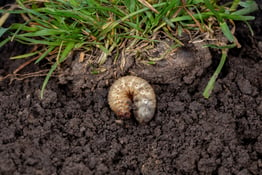As we move deeper into spring, Annual Bluegrass Weevil (ABW) is once again becoming an urgent threat to highly managed turfgrass—especially in Poa annua-dominant fairways, tees, and approaches. Left unchecked, ABW larvae can decimate turf density and playability, impacting performance and aesthetics during peak season.
Understanding their life cycle and acting early is your best defense. Here's how to stay a step ahead:
Scouting for ABW: Timing Is Everything
Adult ABW tend to overwinter in leaf litter and taller grasses before moving to lower-cut turf to lay eggs. Early-season scouting helps pinpoint when ABW adults emerge and when to expect larval activity. Key strategies include:
- Soap flushes or vacuum sampling: Conduct these regularly in known hotspot areas, especially along south-facing slopes, tree lines, and collar edges. For soap flushes, mix 1 fl oz lemon-scented dish soap in 1 gallon of water and pour over a 1 square foot area until saturated. Count or collect adult weevils for 15-20 minutes as they continue to emerge on the tip of leaf blades. Look for small adult weevils with mottled dark coloring and a long snout. Typically, adult counts over 10 per square foot require action, but thresholds may less in more susceptible turfgrass stands.

- Monitor degree-day accumulation: ABW adult movement typically begins around 100–120 GDD (base 50°F, beginning March 1). This often coincides when forsythia are half gold and half green and when redbud and dogwood trees are in full bloom. Online GDD trackers are available, for example: Turf Grass Management.
- Track historical pressure zones: Focus scouting efforts in areas that experienced prior ABW activity, or near favorable nesting spots such as tree lines and taller grasses. These sites are often reinfested year after year.
- Saline rinses for larvae counts: Turf cores are the best way to monitor larval populations as the spring season progresses. Remove a core of about 4-inch depth, cut into quarters, and submerge the soil and turf in a saline solution for one hour. The larvae will emerge from the soil or plant material and float. ABW larvae are cream-colored, with a brown or orange head capsule. Although thresholds for larval counts are not well understood, saline rinses are a great tool for monitoring populations to determine priority areas for treatment.

Suprado Is Your Best Weapon Against ABW
Suprado Insecticide, powered by the active ingredient novaluron, is an insect growth regulator (IGR) uniquely effective against ABW larvae. Here’s why it should be the cornerstone of your control program:
- Stops larvae before they cause damage: Suprado disrupts chitin synthesis, halting molting in developing larvae—the most destructive life stage of ABW.
- Targeted activity with minimal non-target impact: Novaluron is highly specific, making Suprado an excellent fit for Integrated Pest Management (IPM).
- Don’t let resistance win: The unique mode-of-action of novaluron provides a powerful tool to combat pyrethroid-resistant ABW populations.
- Long residual control: Suprado remains active in the upper thatch where ABW larvae reside, offering extended protection during peak egg hatch.

Backed by Science: Suprado Proven in University Research
A recent study by Dr. Ben McGraw at Penn State University highlights the powerful impact of novaluron, the active ingredient in Suprado, on ABW control across multiple life stages.
Key findings from the 3-year field and lab study:
- Consistent larval control: Suprado reduced ABW larvae by up to 100% at high rates, even when applied early in the life cycle, before larvae emerged.
- Ovicidal and sublethal effects: Applications made just after egg-laying reduced larval hatch rates by up to 85%, and adults treated with novaluron showed 52% reduction in viable offspring.
- Flexible timing: Novaluron was effective at multiple application windows, giving superintendents a wider margin for control under variable spring weather conditions.
- Resistance management tool: With growing resistance to pyrethroids, Suprado’s unique mode of action provides an effective alternative that’s less likely to contribute to cross-resistance.
"Lethal and sublethal effects of novaluron, a novel insect growth regulator, on annual bluegrass weevil, Listronotus maculicollis Kirby, lifestages in turfgrass" -McGraw 2025 - Crop Science - Wiley Online Library."
This research reinforces what superintendents across the Northeast have already seen in the field—Suprado delivers reliable, broad-spectrum control of ABW at critical timings while supporting sustainable, resistance-minded programs.
Application Timing & Considerations
- Apply during peak adult migration – generally around 120-170 GDD (base 50°F, beginning March 1). Earlier applications are more effective than late larval instar timings.
- Use the highest label rate (3 fl oz/1,000 ft2) to provide the longest residual control and take advantage of novaluron’s ability to affect multiple life stages of the ABW.
- Apply with a carrier volume of at least 2 gallons per 1,000 ft2 to provide adequate canopy and thatch penetration.
- Allow to dry for 24 hours after application and then irrigate with 0.1-0.2” irrigation to move product into the thatch layer where larvae are active.
- Repeat application in 30 days if needed to target larvae of second and third generations.
- Rotate with other chemistries such as tetraniliprole (diamide) or indoxacarb (oxadiazine) to prevent insecticide resistance.



